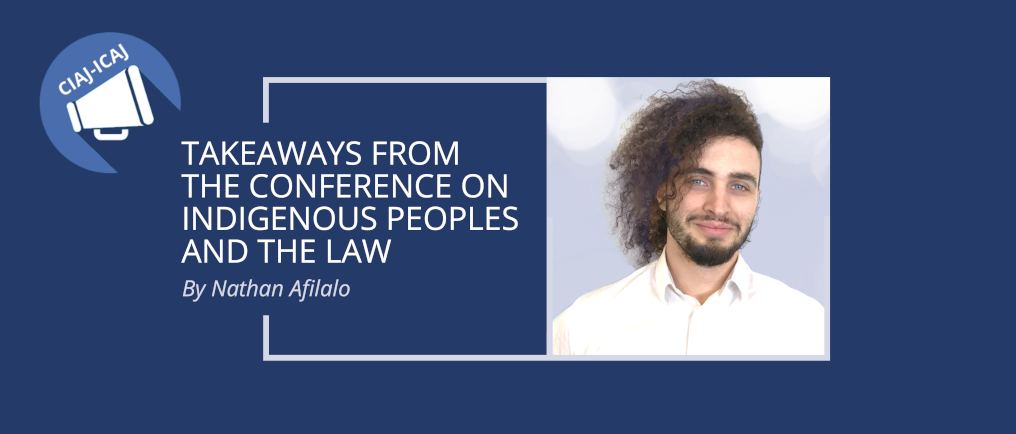Takeaways from CIAJ’s Conference on Indigenous Peoples and the Law

CIAJ’s conference on Indigenous Peoples and the Law took place in Vancouver and online from November 17-19, 2021. A report compiling the highlights of invaluable analysis, comments and recommendations that emerged from the conference was released on National Indigenous Peoples Day, in June 2022.
To help us better understand this report entitled “Asserting Self-Governance,” we asked its author, Lawyer and Legal Researcher Nathan Afilalo, the following questions:
What was the context of the conference?
Over the course of the three days eight panels composed of Indigenous elders, judges, lawyers, academics as well as non-Indigenous legal professionals discussed issues ranging from Indigenous self-governance and legal orders to child welfare and the experiences of Indigenous students in law school. Collectively between in-person and virtual attendance, close to 500 people were able to participate.
Why did you choose that specific topic for your report?
Throughout the various topics discussed and the experiences and wisdom shared a fundamental issue arose: Indigenous self-government. Not a panel passed without its mention. Self-determination was the narrative either from which discussion began or culminated to. The report reproduces the aspects of Indigenous self-government that were highlighted and recurred throughout the conference. Three general areas were covered: the United Nations Declaration on the Rights of Indigenous Peoples as a legal instrument, the legal narratives of Indigenous self-governance, and Indigenous laws and the inherent right to self-governance. The report turns its attention to these issues.
Was it difficult to choose?
It certainly was. Not because other clear themes were lacking. Rather, because there were many alternative lenses which could have served as the narrative through-line of the conference. For example, we could have used the lens of “dialogue” or “decolonization” as framing devices. However, the end goal of either of these ideas was, amongst others, self-determination. So, we chose the most direct route to the message that rang clearest, and which was inherent in nearly every panel.
However, discussing An Act respecting First Nations, Inuit and Métis children, youth and families on panel 5, Cindy Blackstock challenged the primacy of jurisdiction in the conversation. The Act recognizes the inherent right of self-government of Indigenous peoples, which includes jurisdiction in relation to child and family services. Dr. Blackstock, however, pointed out that a greater focus should be placed on immediately improving the health of Indigenous children. She said that many of the issues are long-standing and well-known such as poor housing conditions, poverty and family violence. She argued that, even with the recognition of Indigenous jurisdiction, many of these issues will remain.
Are there concrete measures that we can take from the conference?
There are many. The answer changes for who is reading and what their profession is and what their powers they wield. We can repeat with what Chief Dr. Robert Joseph advocated on the first morning of the conference which was to educate oneself by reaching out to Indigenous People, authorities, and resources. This can begin with those one whose ancestral territories one resides, or whose work impacts the most. More immediately as a Canadian lawyer or judge would be to learn the Act respecting First Nations, Inuit and Métis children, youth and families. On the same panel mentioned above, lawyer Halie Bruce and Dr Sarah Morales discussed a guidebook to the law that at once helps Indigenous communities navigate it and set up their own laws, while also acting as a general guide for legal practitioners who would have to help interpret and use the act. Further, follow the developments in the case law such as the reference decision of the Québec Court of Appeal Renvoi à la Cour d’appel du Québec relatif à la Loi concernant les enfants, les jeunes et les familles des Premières Nations, des Inuits et des Métis, 2022 QCCA 185 which has been appealed to the Supreme Court of Canada.
What was repeated at the conference was for non-Indigenous legal practitioners to learn about Indigenous laws, seek Indigenous sources of authority and to close the gap of unfamiliarity. There are troves of actionable items in sources such as the National Inquiry into Missing and Murdered Indigenous Women and Girls, the Truth and Reconcilliation Commission of Canada, the Royal Commission on Aboriginal Peoples, and the Manitoba Aboriginal Justice Inquiry. The hard work begins by familiarizing yourself with those issues that can be acted upon in the present which build to greater actions we can take further on.
Read the report : Asserting Self-Governance: Report From CIAJ’s Annual Conference on Indigenous Peoples and the Law
This report is available in English and French

